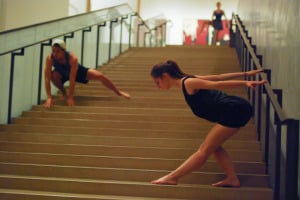
In Aleta Hayes’ “Scene in Action” performance class, dance, fashion and visual art converge in a choreographed synergy of artistic expression. This past Wednesday night, the innovative performance and runway show “took the stage” in a nontraditional sense.
As the course title implies, the dancers’ scene was not static; rather, the fifteen performers moved from the Cantor Arts Center to the adjacent Anderson Collection, which opened just this fall.
Energized by its own setting, the quarter-long “Scene in Action” class draws inspiration from the Cantor’s Robert Frank exhibit of 1950s American photography, as well as the Anderson Collection’s abstract expressionist art. In her course description, Hayes explains that she challenges performers to express “ideas as a direct response to the impulses seen and felt in the art of this period.”
Professor and primary choreographer Aleta Hayes said, “We’re bringing dance to the art. It’s a conversation between two presences.”

This multidisciplinary class is primarily the brainchild of Hayes, a contemporary dance teacher known for combining various art forms. In 2010, she established The Chocolate Heads Movement Band, a group of dancers, visual artists, musicians, spoken word poets and writers.
Cuauhtemoc Peranda ’10, one of the founding members of The Chocolate Heads, returned this fall to serve as the assistant choreographer of “Scene in Action.”
As an application-based seminar, “Scene in Action” started before fall quarter began as a three-week Arts Intensive course, during which dancers trained for hours at a time each day. The course became a one-unit class at the start of the school year.
Ari Echt-Wilson ’17, the stage manager of “Scene in Action,” spent her summer organizing the Cantor’s annual Party on the Edge so she knows the museum space.
“It’s absolutely incredible how the dancers choreographed pieces that speak with the art and bring it to life in a way that I have never seen it before,” Echt-Wilson said.

Indeed, the performers’ movements alongside the art achieves a kind of mutual dialogue. Neither side dominates the conversation — after all, dancers are continually reminded to keep a safe distance from the famous art pieces.
Pieces of the conversation remained unscripted for the performers to fill in on their own. During a rehearsal with Tony Kramer, an emeritus professor in Stanford’s dance department, the dancers practiced “contact improv,” as they improvised movement along their path from the Cantor Arts Center to the Anderson Collection.
Hayes envisioned the show as an authentic experience for everyone involved, including the audience ushered along the dancers’ path.
“[The performance] is kind of like all the ways that we can become, view and experience art. That’s what I would like for everybody — to get the full-blown, 360-degree, multi-sensorial way to experience a physical, visual, even intellectual way of looking at art.”
Contact Jenna Shapiro at jennshap ‘at’ stanford.edu.
